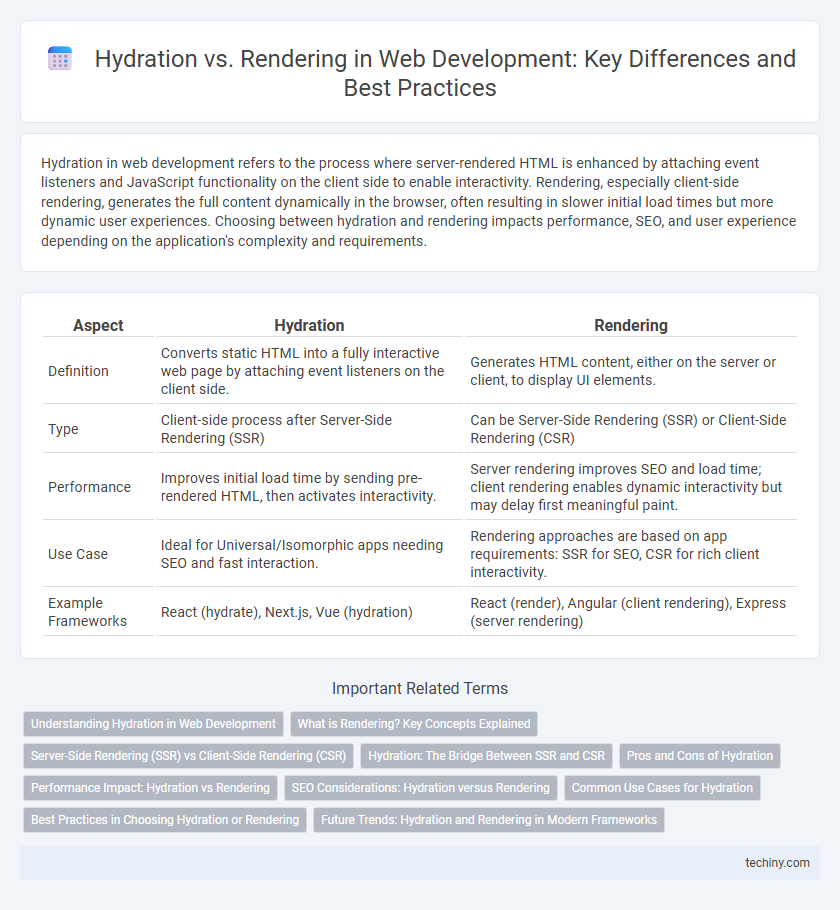Hydration in web development refers to the process where server-rendered HTML is enhanced by attaching event listeners and JavaScript functionality on the client side to enable interactivity. Rendering, especially client-side rendering, generates the full content dynamically in the browser, often resulting in slower initial load times but more dynamic user experiences. Choosing between hydration and rendering impacts performance, SEO, and user experience depending on the application's complexity and requirements.
Table of Comparison
| Aspect | Hydration | Rendering |
|---|---|---|
| Definition | Converts static HTML into a fully interactive web page by attaching event listeners on the client side. | Generates HTML content, either on the server or client, to display UI elements. |
| Type | Client-side process after Server-Side Rendering (SSR) | Can be Server-Side Rendering (SSR) or Client-Side Rendering (CSR) |
| Performance | Improves initial load time by sending pre-rendered HTML, then activates interactivity. | Server rendering improves SEO and load time; client rendering enables dynamic interactivity but may delay first meaningful paint. |
| Use Case | Ideal for Universal/Isomorphic apps needing SEO and fast interaction. | Rendering approaches are based on app requirements: SSR for SEO, CSR for rich client interactivity. |
| Example Frameworks | React (hydrate), Next.js, Vue (hydration) | React (render), Angular (client rendering), Express (server rendering) |
Understanding Hydration in Web Development
Hydration in web development refers to the process where server-rendered HTML is converted into a fully interactive client-side application by attaching JavaScript event listeners and state to the static markup. Unlike initial rendering, which generates the HTML structure, hydration enhances performance by reusing existing DOM elements and avoiding redundant rendering processes. This technique is crucial for improving load times and user experience in frameworks like React, Next.js, and Vue.js.
What is Rendering? Key Concepts Explained
Rendering in web development refers to the process of generating the visual representation of a web page from HTML, CSS, and JavaScript code. Key concepts include server-side rendering (SSR), where the HTML is generated on the server and sent to the client, and client-side rendering (CSR), which relies on the browser's JavaScript engine to build the DOM dynamically. Effective rendering optimizes load times, improves SEO, and enhances user experience by delivering fully or progressively rendered content.
Server-Side Rendering (SSR) vs Client-Side Rendering (CSR)
Server-Side Rendering (SSR) delivers fully rendered HTML from the server, enabling faster initial page loads and improved SEO by allowing search engines to crawl content effectively. Client-Side Rendering (CSR) relies on JavaScript to render content in the browser, which can lead to slower initial loads but smoother user interactions after the page is loaded. Hydration bridges SSR and CSR by attaching JavaScript event handlers to the server-rendered HTML, enabling dynamic functionality without re-rendering the entire page.
Hydration: The Bridge Between SSR and CSR
Hydration in web development seamlessly connects Server-Side Rendering (SSR) with Client-Side Rendering (CSR) by transforming static HTML into a fully interactive web page. This process reuses the SSR-generated markup, binding event listeners and initializing JavaScript without re-rendering the entire DOM, which improves performance and user experience. Efficient hydration reduces load times and enhances SEO, making it a critical technique in modern frameworks like React, Vue, and Next.js.
Pros and Cons of Hydration
Hydration in web development allows reusing server-rendered HTML to enhance performance by reducing initial load times and improving SEO, but it may cause increased JavaScript execution and potential delays in interactivity. It enables fast Time to First Byte (TTFB) and better user experience on slow networks, though it can lead to larger bundle sizes and complexity in state synchronization. While hydration optimizes initial rendering speed, excessive client-side processing can negate these benefits, especially in resource-constrained environments.
Performance Impact: Hydration vs Rendering
Hydration significantly influences web performance by transforming server-rendered HTML into interactive content without re-fetching data, resulting in faster initial page loads compared to full client-side rendering. Rendering on the client side demands more CPU and memory resources, often causing slower interactivity and increased Time to Interactive (TTI). Optimizing hydration processes reduces JavaScript execution time, enhancing user experience by delivering quicker responsiveness on modern web applications.
SEO Considerations: Hydration versus Rendering
Hydration enhances SEO by enabling faster interactive content loading on client-side, improving user engagement signals that search engines value. Server-side rendering (SSR) delivers fully rendered HTML to crawlers, ensuring immediate content visibility for better indexing and search ranking. Combining SSR with hydration optimizes both initial SEO performance and dynamic user experience in web development.
Common Use Cases for Hydration
Hydration is commonly used in server-side rendered applications where initial HTML is delivered to the client for faster load times and SEO benefits, then enhanced with JavaScript for interactivity. It enables frameworks like React, Vue, and Angular to maintain the state and attach event listeners without re-rendering the entire UI. Hydration is particularly effective in dynamic web apps that require a seamless transition from static content to rich client-side interactions.
Best Practices in Choosing Hydration or Rendering
Selecting between hydration and client-side rendering depends on the application's interactivity needs and performance goals. Hydration is best suited for server-rendered content that requires quick interactivity by reusing server HTML and attaching event listeners on the client side. Client-side rendering excels in highly interactive applications where the entire UI is built dynamically, providing flexibility at the cost of initial load speed.
Future Trends: Hydration and Rendering in Modern Frameworks
Future trends in web development emphasize progressive hydration techniques that optimize client-side interactivity while minimizing load times. Frameworks like React Server Components and SolidJS leverage partial or selective hydration to balance server rendering with dynamic content updates, improving performance and scalability. Emerging standards promote seamless integration of static rendering with incremental hydration strategies, enhancing user experience in complex, data-driven applications.
hydration vs rendering Infographic

 techiny.com
techiny.com